14.1.2: Silicate Class - Sheet Silicates
- Page ID
- 18641
14.1.2.1 Serpentine Group Minerals
Serpentine Group Minerals
antigorite Mg6Si4O10(OH)8
chrysotile Mg6Si4O10(OH)8
lizardite Mg6Si4O10(OH)8
Antigorite, chrysotile, and lizardite comprise the serpentine group. Antigorite and lizardite are typically massive and fine grained; chrysotile is fibrous and is one of the few asbestiform minerals. Most of the world’s asbestos is chrysotile; crocidolite and amosite, both amphibole varieties, account for the rest. Chrysotile and lizardite are true polymorphs, but antigorite has a slightly different composition not reflected in its formula.
For more about serpentine polymorphs and occurrences, see the relevant section in Chapter 8.
Antigorite Mg6Si4O10(OH)8
Origin of Name
Named after Valle Antigorio, Italy, the first reported place where this mineral was found.
Hand Specimen Identification
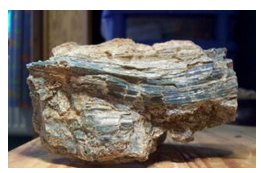
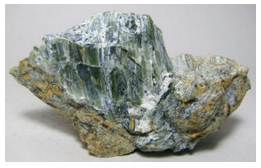
Green color, greasy luster, lack of cleavage, and occurrence as a secondary mineral associated with ultramafic igneous rocks identify antigorite. Figures 14.69 and 14.70 contain photos of typical examples. Antigorite crystals are commonly elongate or platy like those seen in these photos. Other occurrences or morphologies may be more difficult to identify. Chrysotile, one of antigorite‘s polymorphs, is a more fibrous variety of serpentine.
Physical Properties
| hardness | 3 to 4 |
| specific gravity | 2.6 |
| cleavage/fracture | perfect (001)/flexible |
| luster/transparency | vitreous to dull or greasy/translucent |
| color | green, yellow-green, gray-green |
| streak | white |
Properties in Thin Section
In thin section, serpentine typically has a net-like pattern and exhibits wavy extinction. Very low birefringence results in anomalous interference colors. It may be confused with chlorite or brucite. Biaxial (-), α = 1.56, β = 1.57, γ = 1.57, δ = 0.007, 2V = 20° to 60°.
Crystallography
Antigorite is monoclinic, a = 5.32, b = 9.50, c = 14.9, β = 101.9°, Z = 4; space group \(C\dfrac{2}{m}\); point group \(\dfrac{2}{m}\).
Habit
Antigorite is commonly fine grained, massive, or platy, in contrast with fibrous chrysotile.
Structure and Composition
The layered structure consists of paired sheets of SiO4 tetrahedra and Mg(O,OH)6 octahedra stacked on top of each other. Antigorite has a slightly different composition from that indicated by its formula because the ratio of brucite layers to tetrahedral layers is slightly greater than 1. Because atoms in the tetrahedral and octahedral layers have slightly mismatched spacings, layers curve slightly. In antigorite the sheets curve in both directions, alternating on a fine scale, so the overall structure retains sheet-like properties. Small amounts of Ni, Mn, Al, Ti, and Fe typically substitute for Mg.
Occurrence and Associations
Antigorite is a common secondary mineral in mafic and ultramafic igneous rocks. It is also found in some marbles. In some serpentinites it is the only mineral present. Associated minerals include magnesium silicates, carbonates, hydroxides, and oxides, as well as olivine, pyroxene, amphibole, magnesite, spinel, chromite, magnetite, brucite, and talc.
Varieties
Garnierite is a Ni-rich variety of serpentine associated with Ni-peridotites.
Related Minerals
Antigorite is closely related to lizardite and chrysotile (common asbestos). Greenalite, Fe3Si2O5(OH)4, the Fe equivalent of serpentine, has a different structure.
Chrysotile Mg6Si4O10(OH)8
Origin of Name
From the Greek word chrysos and tilos, meaning “golden” and “fiber.”
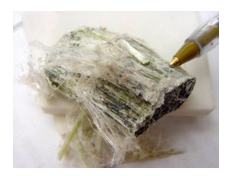
Hand Specimen Identification
Fiber-like, asbestiform appearance is diagnostic. Chrysotile may be distinguished from most other fibrous minerals, including fibrous amphiboles, by its greenish-white color. The photo in Figure 14.71 shows a typical example.
Physical Properties
| hardness | 3 to 5 |
| specific gravity | 2.5 to 2.6 |
| cleavage/fracture | none/uneven |
| luster/transparency | greasy, waxy/translucent |
| color | variable white, greenish white |
| streak | white |
Crystallography
Chrysotile is monoclinic, a = 5.34, β = 9.25, c = 14.65, β = 93°, Z = 8; space group \(A\dfrac{2}{m}\); point group \(\dfrac{2}{m}\).
Habit
A fibrous, asbestiform habit typifies chrysotile.
Structure and Composition
Composition and structure are similar to those of antigorite, except that the mismatch in spacing of the octahedral and tetrahedral layers causes them to curl in one direction only. The curl around completely and, so, form fibers.
Occurrence and Associations
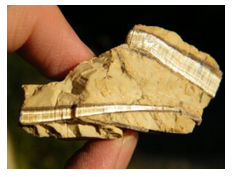
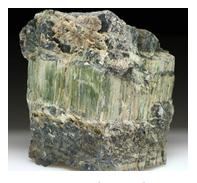
Occurrence and associations are the same as for antigorite. Chrysotile is a major component of some serpentinites, and it sometimes occurs in veins. Figures 14.72 and 14.73 are photos of veined chrysotile. In many serpentine samples, chrysotile layers are associated with a fine-grained platy polymorph called lizardite. Figure 14.73 shows an example
Related Minerals
Chrysotile has two polymorphs, lizardite and antigorite. Greenalite, Fe3Si2O5(OH)4, the Fe equivalent of serpentine, has a different structure. Amosite and crocidolite, varieties of amphibole, are also sometimes asbestiform.
14.1.2.2 Clay Minerals
Clay Mineral Group
montmorillonite Ca-Na clay of variable composition
illite mica-like clay mineral
kaolinite Al2Si2O5(OH)4
pyrophyllite Al2Si4O10(OH)2
talc Mg3Si4O10(OH)2
To a petrologist, the term clay refers to a kind of rock or sediment, usually made of any of a number of minerals referred to as clay minerals. To a mineralogist, clays are a group of sheet silicates with related layered atomic structures. Most are hydrated aluminum or magnesium silicates that form as products of weathering.
Clay minerals fall into three main subgroups that are named after individual species: the smectite, illite, and kaolinite groups. Clays of the smectite group are called expandable clays because they expand when they absorb increasing amounts of water. The most common clay minerals are kaolinite, illite, and montmorillonite. Montmorillonite, a member of the smectite group, is the major component of most bentonite, altered volcanic ash.
Crystal structure and chemistry are variable or poorly determined for many clay varieties. Additionally, some specimens are poorly crystallized and partially amorphous. For these reasons, clay compositions are highly variable and writing precise formulas is often problematic. Clays of the illite and smectite groups are basically three-layer structures (they contain groups of three layers that repeat). Illite group clays, including illite, are transitional from smectites to true micas but lack the alkalis essential to micas.
Kaolinite, which has an atomic arrangement similar to serpentine’s, has a more consistent and ordered atomic arrangement than other clays. It contains a two-layer structure with alternating layers of Al octahedra and Si tetrahedra. Pyrophyllite and talc, sometimes grouped with serpentine, or considered to belong to a separate group, are here grouped with the clays because of similar chemistry. They have, however, three-layer structures more similar to mica structures than to most clays.
For more about clays and occurrences, see Section 7.4.2 in Chapter 7.
Montmorillonite – Ca/Na clay of variable composition
Origin of Name
From its original discovery at Montmorillon, near Limoges, France.
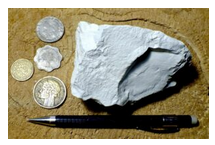
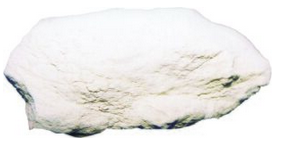

Hand Specimen Identification
Montmorillonite and other clays are difficult to tell apart without X-ray study or chemical analysis. When massive, they are unctuous and earthy if wet. They are typically soft, very fine-grained aggregates if dry. The photos in Figures 14.74 and 14.75 show typical examples. Figure 14.76 shows a powdery specimen.
Physical Properties
| hardness | 1 to 1.5 |
| specific gravity | 2.0 to 2.7 |
| cleavage/fracture | perfect {001} rarely visible/ irregular |
| luster/transparency | dull/sometimes translucent |
| color | variable, white or sometimes gray |
| streak | white |
Properties in Thin Section
Montmorillonite’s optical properties are highly variable due to variable chemistry and crystallinity.
Crystallography
Montmorillonite is monoclinic, a = 5.17, b = 8.94, c = 15.20, β = 99.9, Z = 2; space group \(C\dfrac{2}{m}\); point group \(\dfrac{2}{m}\).
Habit
Earthy masses are typical for this mineral.
Structure and Composition
The structure of montmorillonite is based on groups of three layers. Single sheets of (Al,Mg)(O,OH)6 octahedra are sandwiched between two sheets of SiO4 tetrahedra. Montmorillonite is a member of the smectite group (which also includes nontronite and saponite). It forms solid solutions with beidellite, (Na,Ca)Al2(Si,Al)4O10(OH)2•nH2O. Other minor solid solutions are common, and the amount of H2O is variable.
Occurrence and Associations
Clays are secondary minerals, often residual, formed by alteration of Al-rich silicates.
Origin of Name
The name derives from its original discovery in southern Illinois.
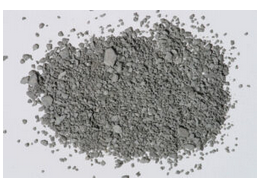
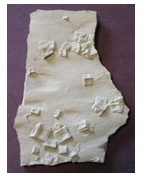
Hand Specimen Identification
Illite and other clays are difficult to tell apart without X-ray study or chemical analysis. When massive, they are unctuous and earthy if wet. They are typically soft very fine-grained aggregates that become powdery if dry. Figure 14.77 shows an example.
Figure 14.78 is a photo of a piece of shale made entirely of illite that replaced all other minerals originally present. The square shapes are former halite crystals that are now entirely clay.
Physical Properties
| hardness | 1 to 2 |
| specific gravity | 2.8 |
| cleavage/fracture | perfect {001} rarely visible/ irregular |
| luster/transparency | dull, earthy/sometimes translucent |
| color | variable, gray, white, silvery, or greenish |
| streak | white |
Properties in Thin Section
Illite’s optical properties are variable due to variable chemistry and crystallinity. It is difficult to identify in thin section.
Crystallography
Illite is monoclinic, a = 5.18, b = 8.98, c = 10.32, β = 101.8, Z = 2; space group \(C\dfrac{2}{m}\); point group \(\dfrac{2}{m}\).
Habit
Fine powders or earthy masses are typical for illite.
Structure and Composition
Illite, sometimes called hydromuscovite or hydromica, has structure and composition closely related to muscovite. It contains, however, more H2O and less K than muscovite. It has a mica-like atomic arrangement but is commonly poorly crystallized. Illite may form solid solutions with montmorillonite or with muscovite.
Occurrence and Associations
Illite is a weathering product of muscovite. It is unstable and alters to other clays in a humid environment.

Related Minerals
Glauconite is a green Fe-rich variety of illite that occurs in some sediments and sedimentary rocks. Figure 14.79 shows glauconite in a sandstone. Brammalite is an Na-rich variety of illite, and avalite is a Cr-containing variety.
Kaolinite Al2Si2O5(OH)4
Origin of Name
From the Chinese word Kao-ling, the name of the hill that was the first source of kaolinite sent to Europe for ceramics.
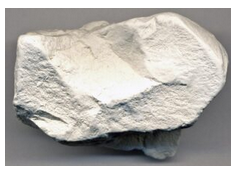
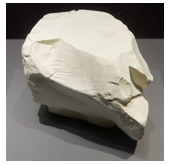
Hand Specimen Identification
A white color and clay-like properties, including softness, habit, feel, and earthy smell, help identify kaolinite. Without X-ray data, however, it cannot be distinguished from other white or light-colored clays. These two figures contain photos of typical kaolinite.
Physical Properties
| hardness | 2 to 2.5 |
| specific gravity | 2.6 |
| cleavage/fracture | perfect (001) but rarely seen |
| luster/transparency | dull/sometimes translucent |
| color | white or sometimes very light gray |
| streak | white |
Properties in Thin Section
Optical identification of kaolinite is very difficult. Biaxial (-), α = 1.556, β = 1.563, γ = 1.565, δ = 0.007, 2V = 40°.
Crystallography
Kaolinite is triclinic, a = 5.15, b = 8.92, c = 7.38, α = 91.8°, β = 104.8°, = 90.0°, Z = 2; space group P1; point group 1.
Habit
Kaolinite is usually massive or a fine-grained aggregate; rare platy, pseudohexagonal crystals have been found.
Structure and Composition
Kaolinite has a two-layer structure: layers of Al(O,OH)6 octahedra alternate with sheets of SiO4 tetrahedra. Several minor substitutions are possible: alkalis or alkaline earths may be present, as well as excess H2O.
Occurrence and Associations
Kaolinite is a common secondary mineral, forming after aluminous silicates. It is a rock-forming mineral, a component of soils, and replaces feldspar in rocks undergoing weathering. Associated minerals include quartz and other minerals resistant to alteration.
Related Minerals
In composition and structure, kaolinite is equivalent to an aluminous serpentine. It has two polymorphs, dickite and nacrite.
Pyrophyllite Al2Si4O10(OH)2
Origin of Name
From the Greek word pyro and phyllon, meaning “fire” and “leaf,” in reference to this mineral’s behavior when heated.
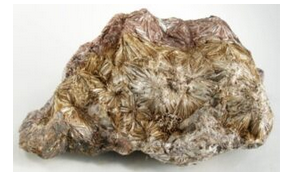
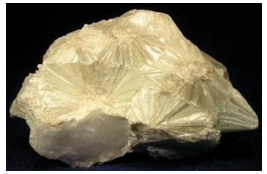
Hand Specimen Identification
Softness, somewhat greasy feel, cleavage, and association help identify pyrophyllite . These two photos show classic stellate (radiating star-like habit) pyrophyllite. This texture is diagnostic for pyrophyllite. When not stellate, pyrophyllite cannot be distinguished easily from light-colored clays or related minerals without X-ray data. It may be confused with talc, but talc is softer and has a soapier feel.
Physical Properties
| hardness | 1 to 2 |
| specific gravity | 2.8 |
| cleavage/fracture | perfect basal (001) |
| luster/transparency | pearly/translucent |
| color | white |
| streak | white |
Properties in Thin Section
High birefringence, perfect cleavage, bird’s-eye maple appearance, and lack of color identify pyrophyllite. Talc and muscovite have smaller 2Vs. Biaxial (-), α = 1.553, β = 1.588, γ = 1.600, δ = 0.047, 2V = 52° to 62°.
Crystallography
Pyrophyllite is triclinic, a = 5.16, b = 8.96, c = 9.35, α = 90.03°, β = 100.37°, γ = 89.75°, Z = 2; space group C1; point group 1.
Habit
Individual crystals are unknown. Pyrophyllite is usually massive and foliated, sometimes forming platy or radiating masses like those seen in the photos above.
Structure and Composition
The three-layered structure of pyrophyllite consists of individual sheets of Al(O,OH)6 octahedra sandwiched between sheets of SiO4 tetrahedra. Fe may replace some of the Al; minor Mg, Ca, Na, or K may also be present.
Occurrence and Associations
Pyrophyllite is found in low- and medium-grade metamorphosed shales. Associated minerals typically include kyanite, feldspar, and quartz.
Related Minerals
Pyrophyllite is isostructural with talc, Mg3Si4O10(OH)2, and structurally similar to minnesotaite, Fe3Si4O10(OH)2.
Talc Mg3Si4O10(OH)2
Origin of Name
Unknown; perhaps from the Arabic word talq, meaning “pure.”
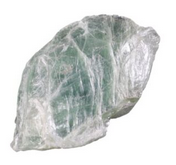
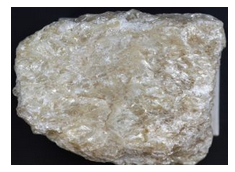
Hand Specimen Identification
Softness (H = 1) and a greasy feel usually identify talc. It is typically massive with a pearly luster. It is sometimes confused with pyrophyllite, serpentine, or chlorite.
Figure 14.84 shows green pearly talc, a common talc appearance. Figure 14.85 show more typical massive white talc in a talc schist.
Physical Properties
| hardness | 1 |
| specific gravity | 2.8 |
| cleavage/fracture | perfect basal (001)/flexible |
| luster/transparency | resinous, pearly, or silky/translucent |
| color | gray, white |
| streak | white |
Properties in Thin Section
In thin section, talc appears similar to muscovite, chlorite, and pyrophyllite, but has a smaller 2V and often appears smeared or poorly defined when viewed under crossed polars. Biaxial (-), α = 1.54, β = 1.58, γ = 1.58, δ = 0.05, 2V = 6° to 30°.
Crystallography
Talc is monoclinic, a = 5.29, b = 9.10, c = 18.81, β = 100.00°, Z = 4; space group Cc; point group m.
Habit
Rare tabular pseudohexagonal crystals have been found, but talc is usually very fine grained and massive.
Structure and Composition
Talc is isostructural with pyrophyllite, being composed of layers of Mg(O,OH)6 octahedra sandwiched between layers of SiO4 tetrahedra. Talc may contain some Ti, Ni, Fe, or Mn but is generally quite pure.
Occurrence and Associations
Talc is a primary mineral in some low-grade metamorphic rocks, including marbles and ultramafic rocks, and less commonly a secondary mineral in mafic igneous rocks.
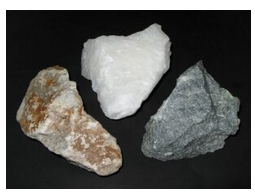
Varieties
When massive, talc is sometimes called steatite or soapstone. Figure 14.86 shows three examples.
Related Minerals
Talc is isostructural with pyrophyllite, Al2Si4O10(OH)2, and structurally similar to minnesotaite, Fe3Si4O10(OH)2.
1.2.3 Micas
Mica Group Minerals
Biotite Series
phlogopite KMg3(AlSi3O10)(OH)2
annite KFe3(AlSi3O10)(OH)2
Other Micas
muscovite KAl2(AlSi3O10)(OH2)
margarite CaAl2(Al2Si2O10)(OH2)
lepidolite K(Li,Al)2-3(AlSi3O10)(OH)2
The mica group consists of a number of minerals, the principal ones being biotite and muscovite. All micas are flexible sheet silicates and, when coarse enough, display excellent basal cleavage, a vitreous luster, and are translucent.
The name biotite refers to a series dominated by end members phlogopite and annite. Mg-rich biotite (phlogopite) and Fe-rich biotite (annite) are often difficult to distinguish without detailed X-ray or chemical analyses. In common use, mineralogists often call a ny black mica biotite and reserve the term phlogopite for brown micas. Color is not, however, a reliable way to distinguish the two.
Muscovite, sometimes referred to as a white mica, is in sharp contrast to biotite. However, it may be confused with margarite, lepidolite, and some other rarer micas that have a light or silvery color. Margarite is one of the brittle micas, a group that includes rarer clintonite and xanthophyllite. Lepidolite is an Li-rich mica found in pegmatites. Although annite and phlogopite enjoy complete solid solution, only limited solution is possible among other end members.
For more general information about the mica group, see Section 6.4.4 in Chpter 6.
Phlogopite KMg3(AlSi3O10)(OH)2
Origin of Name
From the Greek word phlogopos, meaning “fiery,” in reference to this mineral’s brown color.
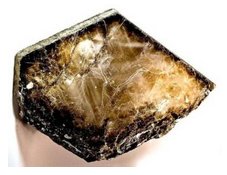
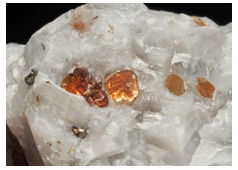
Hand Specimen Identification
Phlogopite, end-member Mg-biotite, is usually identified by micaceous cleavage, brown color, and association. Sometimes euhedral crystals have a pseudohexagonal shape. If not brown, phlogopite is indistinguishable from other composition biotite without additional analytical data.
Figure 14.87 shows a very large pseudohexagonal book of phlogopite from a pegmatite near Bancroft, Ontario. Figure 14.88 is a photo of brown flakes of phlogopite, surrounded by calcite, in a marble.
Physical Properties
| hardness | 2.5 to 3 |
| specific gravity | 2.8 |
| cleavage/fracture | perfect basal (001)/elastic |
| luster/transparency | pearly/transparent |
| color | yellow-brown to brown |
| streak | white |
Properties in Thin Section
Phlogopite is similar to other micas in thin section. It has a smaller 2V than muscovite and is often colored light brown. It may be pleochroic, but not as much as Fe-rich biotite. Biaxial (-), α = 1.56, β = 1.60, γ = 1.60, δ = 0.04, 2V = 0° to 20°.
Crystallography
Phlogopite is monoclinic, a = 5.31, b = 9.19, c = 10.15, β = 95.18°, Z = 2; space group \(C\dfrac{2}{m}\); point group \(\dfrac{2}{m}\).
Habit
Coarse books of pseudohexagonal crystals are distinctive but uncommon. More frequently, phlogopite is disseminated as irregular grains or flakes or foliated masses.
Structure and Composition
The basic phlogopite structure is similar to the structures of talc and pyrophyllite: two tetrahedral SiO4 layers surround an octahedral Mg(O,OH)6 layer. Unlike talc and pyrophyllite, however, the three-layer sandwiches are linked by K+ ions occupying large sites between them. Fe often substitutes for Mg, leading to complete solid solution with annite, KFe3(AlSi3O10)(OH)2. Al substitutes for both Mg and Si, creating solid solutions with siderophilite, K(Fe,Al)3(Si,Al)4 O10(OH)2. Limited solid solution with muscovite, KAl2(AlSi3O10)(OH)2, is also possible. Mn, Ti, and a number of alkalis and alkaline earths may also be present, and F may replace some OH.
Occurrence and Associations
Phlogopite is a common mineral in marbles where it associates with calcite, dolomite, quartz, diopside, and tremolite; less commonly, it is found in highly magnesium-rich igneous rocks or in pegmatites.
Related Minerals
Phlogopite has several different polymorphs; they are difficult to tell apart without detailed X-ray studies. It is isostructural with muscovite, KAl2(AlSi3O10)(OH)2, and isotypical with other micas, forming complete or limited solutions with most.
Biotite K(Mg,Fe)3(AlSi3O10)(OH)2
Origin of Name
Named after J. B. Biot (1774–1862), a French scientist who conducted detailed studies of micas.

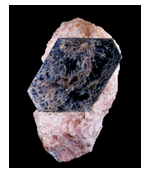
Hand Specimen Identification
Biotite is the name given to a series of dark-colored micas that range from phlogopite (Mg-biotite) to annite (Fe-biotite). Micaceous cleavage, vitreous luster, and sometimes pseudohexagonal crystals are keys to identification. The biotite flakes in Figures 14.89 and 14.90 are typical. The pseudohexagonal biotite crystal in Figure 14.90 is on top of pink calcite.
Biotite is most commonly black but may be brown or tan or, less commonly, other colors. Biotite may be confused with other micas, especially chlorite. Composition is variable and cannot be determined without analysis.
Physical Properties
| hardness | 2.5 to 3 |
| specific gravity | 2.9 – 3.1 |
| cleavage/fracture | perfect basal {001}/ragged |
| luster/transparency | vitreous/transparent to opaque |
| color | black, greenish black, brown-black |
| streak | white |
Properties in Thin Section
Brown, red, or green in thin section, biotite exhibits strong pleochroism, perfect cleavage, bird’s-eye extinction, and parallel or near-parallel extinction. Biaxial (-), α = 1.57, β = 1.60, γ = 1.61, δ = 0.04, 2V = 0° to 32°. Stilpnomelane, a rarer related sheet silicate, looks much like biotite but lacks “bird’s eye” extinction.
Crystallography
Biotite is monoclinic, pseudohexagonal, a = 5.33, β = 9.31, c = 10.16, b = 99.3°, Z = 2; space group \(C\dfrac{2}{m}\); point group \(\dfrac{2}{m}\).
Habit
Foliated books of pseudohexagonal crystals of biotite are distinctive but uncommon. More frequently, biotite is disseminated as irregular grains or flakes or foliated masses.
Structure and Composition
The basic biotite structure is identical to that of phlogopite: two tetrahedral layers surround an octahedral layer. The three-layer sandwiches are linked by K+ ions occupying large sites between them. Fe mixes freely with Mg in octahedral sites, leading to complete solid solution between the two principal biotite end members: annite, KFe3(AlSi3O10)(OH)2, and phlogopite, KMg3(AlSi3O10)(OH)2. Coupled substitution of Al for both Mg and Si creates limited solid solutions with siderophilite, K(Fe,Al)3(Si,Al)4 O10(OH)2. Minor solid solution with muscovite, KAl2(AlSi3O10)(OH)2, is also possible: two Al replace three (Fe,Mg), leaving every third octahedral site vacant. Mn, Ti, and a number of alkalis and alkaline earths may also be present, and F may replace some OH.
Occurrence and Associations
Biotite is common in a wide variety of igneous and metamorphic rocks and in immature sediments. Associated minerals include other micas, amphiboles, quartz, and feldspars.
Varieties
Annite and phlogopite are names given to end-member Fe- and Mg-biotite. Siderophilite is the name of biotite that contains excess Al.
Related Minerals
Biotite is isostructural or isotypical with other micas, and similar in many ways to other sheet silicates. Several biotite polymorphs differ in the ways the tetrahedral and octahedral sheets are stacked.
Muscovite KAl2(AlSi3O10)(OH)2
Origin of Name
Named after the Muscovy Principality of thirteenth-century Russia, which produced muscovite for use in window panes.
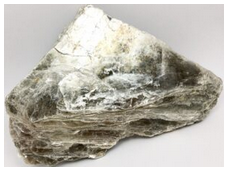

Hand Specimen Identification
Muscovite is the most common mineral of the mica family. Micaceous character and silver color distinguish this mineral. It may be confused with other white micas, such as paragonite or margarite. Certain identification requires optical, X-ray, or chemical analysis. Figures 14.91 and 14.92 contain photos of muscovite from Brazil.
Physical Properties
| hardness | 2 to 2.5 |
| specific gravity | 2.8 |
| cleavage/fracture | perfect basal (001)/elastic |
| luster/transparency | sometimes pearly, vitreous/translucent |
| color | silvery white, sometimes gray-brown |
| streak | white |
Properties in Thin Section
In thin section, muscovite appears clear, has moderate to high birefringence, sometimes has bird’s-eye extinction, a high index of refraction, and one perfect cleavage. It may be confused with colorless phlogopite or with other white micas. Biaxial (-), α = 1.565, β = 1.596, γ = 1.600, δ = 0.035, 2V = 30° to 40°.
Crystallography
Muscovite is monoclinic, a = 5.19, b = 9.04, c = 20.08, β = 95.5°, Z = 4; space group \(C\dfrac{2}{c}\); point group \(\dfrac{2}{m}\).
Habit
Individual crystals are rare. Muscovite typically forms books of mica, often in massive aggregates, with or without a pseudohexagonal outline, or is found as disseminated grains within a quartz–feldspar matrix. Penetration twins may be present.
Structure and Composition
The muscovite structure is identical to that of biotite except that Al has replaced two out of every three (Fe,Mg). Very limited solid solution with annite, KFe3(AlSi3O10)(OH)2, and with phlogopite, KMg3(AlSi3O10)(OH)2, are possible. Na may be present, resulting in solid solution toward paragonite, NaAl2(AlSi3O10)(OH)2. Other alkalis and alkaline earths may also replace K. Li may replace some Al, and F may replace some OH.
Occurrence and Associations
Muscovite is found in many silicic to intermediate igneous rocks, in a wide variety of metamorphic rocks, and in some immature sediments. Associated minerals include other micas, K-feldspar, and quartz.
Varieties
Sericite is a fine-grained form of muscovite created by alteration of feldspars and other alkali-aluminum silicates.
Related Minerals
Muscovite is isotypical with biotite and other micas, such as lepidolite, K(Li,Al)2-3(AlSi3O10)(OH)2. It shares many properties with paragonite, NaAl2(AlSi3O10)(OH)2, and with margarite, CaAl2(Al2Si2O10)(OH)2. Several different muscovite polymorphs are known.
Margarite CaAl2(Al2Si2O10)(OH)2
Origin of Name
From the Greek word margarites, meaning “pearl,” a reference to margarite’s color and luster.

Hand Specimen Identification
Margarite is characterized by its micaceous nature, brittleness, and pearly luster. Association and brittleness usually distinguish it from other white micas. Some specimens have a distinctive silvery-pink color. Figure 14.93 is a photo of pink margarite on top of green chlorite. It is from a classic collecting site in western Massachusetts.
Physical Properties
| hardness | 3.5 to 5 |
| specific gravity | 3.1 |
| cleavage/fracture | perfect basal (001)/uneven |
| luster/transparency | vitreous/transparent to translucent |
| color | gray-yellow, pinkish silver |
| streak | white |
Properties in Thin Section
Margarite is colorless in thin section, resembling muscovite and other white micas. It is distinguished by a higher index of refraction, lower birefringence, and a 6° to 8° extinction angle. Biaxial (-), α = 1.635, β = 1.645, γ = 1.648, d = 0.013, 2V = 45o.
Crystallography
Margarite is monoclinic, a = 5.14, b = 9.00, c = 19.81, β = 108o, Z = 4; space group \(C\dfrac{2}{c}\); point group \(\dfrac{2}{m}\).
Habit
Margarite is typically found in massive, micaceous books and aggregates; individual crystals are rare.
Structure and Composition
Margarite has a structure transitional between muscovite and chlorite. Because the interlayer site is occupied by Ca2+ rather than K+ (as in most other micas), bonds between layers are stronger. Thus, margarite is more brittle (and so is called brittle mica). Minor Na+ and K+ and may replace Ca2+; charge balance is maintained by replacement of Al ions by Be, Ba, Sr, K, Mn, Fe, and Mg ions. Excess OH may also be present.
Occurrence and Associations
Margarite, typically found with corundum and diaspore, is most commonly an alteration product of corundum.
Related Minerals
Margarite is a member of the brittle mica group. Other members of the group include clintonite and xanthophyllite, both having compositions Ca(Mg,Al)2-3(Al2Si2O10)(OH)2. Margarite also shares similarities with stilpnomelane, (K,Ca,Na)(Fe,Mg,Al)8(Si,Al)12(O,OH)36·nH2O.
Lepidolite K(Li,Al)(AlSi )(OH)2
Origin of Name
From the Greek word lepid, meaning “scale,” referring to this mineral’s usual habit.
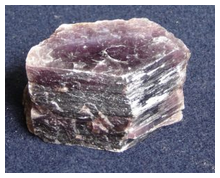
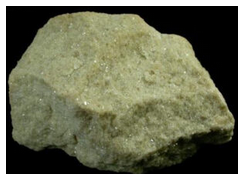
Hand Specimen Identification
Micaceous habit, often a distinctive lilac-gray or rose color (as in Figure 14.94), and association usually serve to identify lepidolite. It sometimes comes in other colors, making identification problematic. For example, Figure 14.95 shows a sample containing small crystals of yellow lepidolite.
Physical Properties
| hardness | 2.5 to 4 |
| specific gravity | 2.9 |
| cleavage/fracture | perfect basal {001}/uneven |
| luster/transparency | pearly, vitreous/translucent |
| color | lilac to rose-red; less commonly, yellow, gray, white |
| streak | white |
Properties in Thin Section
Lepidolite is generally colorless in thin section. It resembles muscovite but has lower relief and lower birefringence. Biaxial, α = 1.53 to 1.55, β = 1.55 to1.59, γ = 1.55 to 1.59, δ = 0.02 to 0.04, 2V = 0o to 60o.
Crystallography
Lepidolite is monoclinic, a = 5.211, b = 8.97, c = 20.16, β = 100.8o, Z = 4; space group \(C\dfrac{2}{m}\); point group \(\dfrac{2}{m}\).
Habit
Lepidolite usually forms coarse- to fine-grained scaly aggregates. It is less commonly disseminated as fine flakes or coarser crystals in pegmatites.
Structure and Composition
Lepidolite is a complex solid solution series with a structure similar to muscovite. Chemically, it is equivalent to muscovite with half or more of the octahedral Al replaced by Li and, perhaps, Fe or Mg. In addition, other alkalis may substitute for K, and O or F may replace OH.
Occurrence and Associations
Lepidolite is restricted to Li-rich pegmatites. Associated minerals include other Li-bearing minerals such as tourmaline, amblygonite, and spodumene, as well as the more common muscovite, feldspar, and quartz.
Related Minerals
Lepidolite has several polymorphs that cannot be differentiated without detailed X-ray study. It is isotypical with other micas.
1.2.4 Chlorite Mineral Group
Chlorite End Members
clinochlore (Mg5Al)(AlSi3)O10(OH)8
chamosite (Fe5Al)(AlSi3)O10(OH)8
sudoite Mg2(Al,Fe)3(AlSi3O)10(OH)8
nimite (Ni5Al)(AlSi3)O10(OH)8
pennantite (Mn,Al)(Si,Al)4O10(OH)8
Chlorite is the general name given to a number of Mg- or Fe-rich sheet silicates with similar chemistry and structure. Other sheet silicates with the same atomic arrangement are included in the chlorite group, which contains more than 15 different species.
Common Mg-Fe chlorite compositions vary widely, and they may contain variable amounts of Al. The complex chemical variations and similarity of all Fe-Mg chlorites make identifying individual species problematic, but a few ideal end-member compositions have been given names. Some examples are listed in the blue box. The most common chlorites have compositions close to end-member clinochlore, Mg5Al(AlSi3)O10(OH)8, described below.
Structurally, all chlorites consist of alternating talc-like and brucite-like layers. In both kinds of layers, Fe and Al may substitute for Mg; other elements, such as Ni, may also be present. Composition cannot be determined without X-ray or chemical data, and occasionally with careful optical studies.
Chlorite (clinochlore) (Mg5Al)(AlSi3O10)(OH)8
Origin of Name
From the Greek words klinein, meaning “to incline”, referring to the mineral’s inclined optic axes, and chloros, meaning “green.”
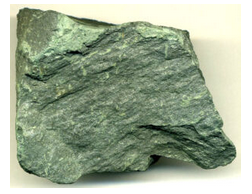

Hand Specimen Identification
When fine-grained, a deep green color and occurrence as a replacement mineral generally identify chlorite. The many individual species and varieties cannot be distinguished easily. Chlorite is sometimes confused with talc.
In metamorphic rocks, chlorite may be very fine grained. Figure 14.96 shows the most typical occurrence of chlorite, in a chlorite schist that is so fine grained that individual crystals cannot be seen. The green color, however, reveals the mineral’s presence. If crystals are visible (uncommon) in hand specimen, green color, pseudohexagonal shape, and micaceous habit and cleavage are usually adequate to identify chlorite. Figure 14.97 shows an example of a chlorite crystal.
Physical Properties
| hardness | 2 to 2.5 |
| specific gravity | 3.0 |
| cleavage/fracture | perfect basal (001)/flexible |
| luster/transparency | vitreous/transparent to translucent |
| color | green, variable |
| streak | white or light green |
Properties in Thin Section
Chlorite is generally green and sometimes green-brown in thin section. It usually exhibits yellow-green-brown pleochroism and has moderate to moderately high relief. Birefringence is very low. Interference colors normally are between anomalous blue, brown, or purple and first-order yellow. Biaxial (-), α = 1.56 to 1.60 , β = 1.57 to 1.61, γ = 1.58 to 1.61, δ = 0.006 to 0.020, 2V = 0° to 40°.
Crystallography
Chlorite is monoclinic, a = 5.37, b = 9.30, c = 14.25, β = 97.4°, Z = 2; space group \(C\dfrac{2}{m}\); point group \(\dfrac{2}{m}\).
Habit
When crystals can be seen, chlorite has habits similar to the other micas: foliated books, scaly aggregates, and individual flakes in a quartz–feldspar matrix are typical. Rare pseudohexagonal crystals are known.
Structure and Composition
The structure of chlorite consists of stacked talc, Mg3Si4O10(OH)2 and brucite, Mg(OH)2, layers. The stacking order is variable, leading to a great deal of variety. In both kinds of layers, Al replaces some of the Mg, and in most chlorites Fe is present as well. A general formula, (Mg,Fe,Al)(Si,Al)4O10(OH)8, does not describe all of the compositional variability.
Occurrence and Associations
Chlorite is a common mineral in low- to intermediate-grade metamorphic rocks, diagnostic of the greenschist facies. It is also a common secondary mineral after biotite, muscovite, and many mafic silicates in igneous and metamorphic rocks, and is sometimes found in sediments. Many greenish rocks owe their color to the presence of chlorite. Associated minerals include quartz and feldspars, epidote, muscovite, actinolite, albite, and a number of ferromagnesian silicates.
Varieties
Names given to some idealized chlorite compositions include clinochlore, (Mg5Al)(AlSi3O10)(OH)8; chamosite, (Fe5Al)(AlSi3O10)(OH)8; nimite, (Ni5Al)(AlSi3O10)(OH)8; and pennanite, (Mn,Al)6(Si,Al)4O10(OH)8.
Related Minerals
Chlorite has many varieties and polymorphs. Other similar minerals include cookeite, LiAl4(AlSi3O10)(OH)8; sudoite, Mg2(Al,Fe3)(AlSi3O10)(OH)8; and a number of other hydrated aluminosilicates.
1.2.5 Other Sheet Silicates
Other Sheet Silicates
prehnite Ca2Al(AlSi3O10)(OH)2
apophyllite KCa4Si8O20F•8H2O
sepiolite Mg4Si6O15(OH)2•6H2O
chrysocolla Cu4Si4O10H4(OH)8•nH2O
glauconite ~(K,Na)(Fe,Mg,Al)2(Si,Al)4O10(OH)2
A number of other minerals are sheet silicates, or closely related to sheet silicates, but do not fit into any of the groups previously discussed. These include prehnite, apophyllite, sepiolite, chrysocolla, and glauconite. Prehnite and apophyllite, secondary minerals similar in occurrence and association to zeolites are discussed below.
Due to highly variable properties, chemistry, and structure, sepiolite, chrysocolla, and glauconite are not discussed in detail in this book. Glauconite and sepiolite are both clay-like minerals, and chrysocolla is a secondary copper mineral of highly variable chemistry. Okenite, a mineral closely related to zeolites and the others listed in this box, contains both chains and sheets of silicon tetrahedra and so does not fit conveniently into either class.
Prehnite Ca2Al(AlSi3O10)(OH)2
Origin of Name
Named after H. van Prehn, who discovered this mineral in 1774.

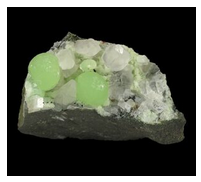
Hand Specimen Identification
Prehnite, although not a zeolite, occurs in many of the same places that zeolites occur. When green and botryoidal (typical) it is easily identified. Otherwise it may be difficult to distinguish from zeolites, and may also be confused with hemimorphite and smithsonite.
The photo in Figure 14.98 shows a classic example of green botryoidal prehnite. The photo in Figure 14.99 shows spheres of green prehnite with clear calcite.
Physical Properties
| hardness | 6 to 6.5 |
| specific gravity | 2.9 |
| cleavage/fracture | good basal (001)/uneven |
| luster/transparency | vitreous/transparent to translucent |
| color | pale green |
| streak | white |
Properties in Thin Section
Prehnite is colorless in thin section. It has moderate birefringence but often exhibits anomalous interference figures, sometimes with an “hourglass” or “bow tie” structure. It may be confused with lawsonite, pumpellyite, epidote, datolite, and a number of zeolites but has higher birefringence than all of them. Biaxial (+), α = 1.625 , β = 1.635, γ = 1.655, δ = 0.03, 2V = 65° to 70°.
Crystallography
Prehnite is orthorhombic, a = 4.65, b = 5.48, c = 18.49, Z = 2; space group P2cm; point group mm2.
Habit
Botryoidal, globular, barrel-shaped, and reniform aggregates are typical. Rarely, prehnite is found as individual tabular or prismatic crystals.
Structure and Composition
Prehnite consists of tetrahedral sheets connected by octahedra. Fe may replace some of the Al.
Occurrence and Associations
Prehnite may be a product of low-grade metamorphism but is more commonly a secondary mineral that forms as crusts or fillings in basalt and other mafic igneous rocks. Associated minerals include pumpellyite, zeolites, datolite, pectolite, and calcite.
Related Minerals
Prehnite is sometimes grouped with the zeolites because of its similar occurrences. Its structure, however, is significantly different.
Apophyllite KCa4Si8O20F•8H2O
Origin of Name
From the Greek words for “form” and “leaf,” because it becomes flaky on heating.

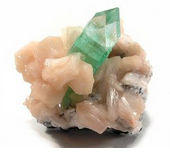
Hand Specimen Identification
Like prehnite, apophyllite often occurs where zeolites occur. Tetragonal prismatic crystals, often with terminating pyramid faces, a vitreous luster, and perfect one direction of cleavage perpendicular to prism faces may identify this mineral (especially if it is clear and uncolored). The clear crystals in Figure 14.100 are classic examples.
Figure 14.101 shows a green variety of apophyllite on top of stilbite, a common zeolite. The crystals in both photos have similar shapes, and traces of apophyllite’s one perfect cleavage can be seen in both photos.
Physical Properties
| hardness | 4.5 to 5 |
| specific gravity | 2.3 |
| cleavage/fracture | one perfect (001), poor {110}/uneven |
| luster/transparency | pearly, vitreous/translucent |
| color | clear, white, green, or sometimes gray |
| streak | white |
Properties in Thin Section
Apophyllite has negative relief, is colorless, and has very low birefringence. It has perfect (001) cleavage, and often exhibits anomalous interference colors. Uniaxial (+), ω = 1.535, ε = 1.537, δ = 0.002.
Crystallography
Apophyllite is tetragonal, a = 8.96, c = 15.78, Z = 2; space group \(P\dfrac{4}{m}\dfrac{2_{1}}{n}\dfrac{2}{c}\); point group \(\dfrac{4}{m}\dfrac{2}{m}\dfrac{2}{m}\).
Habit
Apophyllite crystals typically have tetragonal prismatic faces with pinacoids and bipyramids. They often display pseudosymmetry, appearing to be combinations of cubes and octahedra.
Structure and Composition
Sheets in the apophyllite structure are composed of 4- and 8-member rings of SiO4 tetrahedra. Interlayer Ca, K, and F link the tetrahedral sheets.
Occurrence and Associations
Apophyllite is a secondary mineral that sometimes lines openings in basalt and other mafic igneous rocks. Associated minerals include zeolites, datolite, calcite, and pectolite.


